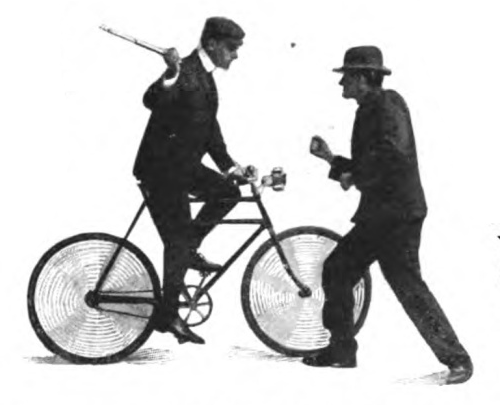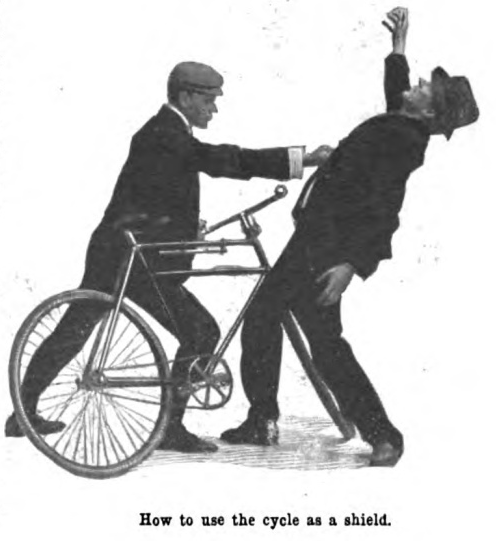Editor’s note: The following is an excerpt from “Self-protection on a Cycle,” an article written by Marcus Tindal and published in 1901 in Pearson’s Magazine. Tindal seems to have been inspired by the popularity of bartitsu — a gentlemanly martial art focused on everyday self-defense with ordinary objects — in creating these methods by which cyclists could ward off attack. Your mileage in employing them may vary!
It is a mistake to suppose that all the romance of the night roads is past and done with—the romance of the merry old days when highwaymen lay in wait for the benighted traveller on every lonely bit of country road, in every wood, on every stretch of waste land. Attacks by foot-pads on cyclists recall at least some of the glamor of the old stand-and-deliver times to the minds of those who read of these highway robberies every now and again in the papers—though the cyclists assaulted may not look upon the matter in quite so romantic a light!
It might appear at first sight that a cyclist would fall an easy prey to a highway robber, especially at nighttime—that he could be attacked with more certainty of success than could a horseman. In the first place, a cyclist riding at night will usually comply with regulations, and carry a lamp. Thus he will herald his advance from afar off. He is astride a steed, moreover, from which he may be upset far more easily than if he were astride good, solid horseflesh—a stick in the spokes of his wheel, a sudden jerk to the handlebars, or a wire stretched taut across his road—and he is thrown, inevitably.
On the other hand, consider the cyclist’s advantages. He comes silently, and passes swiftly, like a spirit. A moment too soon, a moment too late in attacking, and the foot-pad loses his prey. The cyclist thus has a fair chance of passing the foot-pad before the latter can act, and if he rides without a light he has more than a fair chance of passing unperceived—unless, of course, a cunning trap has been laid beforehand.
Supposing, too, that it came to a fight, whether by day or by night, the cyclist has a weapon in his cycle with which he may baffle attack in more ways than are at first apparent. Self-protection awheel is an art full of possibilities. The cyclist who is a skillful rider, who possesses pluck and dash, who has mastered the elementary rules of defense on a bicycle, and who is armed with a knowledge of how to use a machine to the best advantage as a weapon, may rest content that he is able to defend himself perfectly when attacked under the majority of likely conditions.
Perhaps the commonest occasion when a little knowledge of the art of self-defense awheel would prove of greatest use is when a rider is menaced by a rough who blocks the road. A lady, say, is riding alone on a country road, when an approaching tramp suddenly assumes a hostile attitude, standing before her with legs apart and arms outstretched, effectively barring the way.

Now this is the secret for removing the tramp, and for riding past in safety. Let the lady put on a spurt, and ride, point blank, at her assailant, then swerve at the last moment. Certainly this requires nerve, but it is really simple, and marvelously effective. The tramp cannot overcome the instinct of self-protection which makes him jump to one side, when the cyclist, of course, at once swerves in the other direction.

Nearly every cyclist carries a weapon on his machine which, under many circumstances, he may use with great effect: a strong, long, heavy metal pump offers as convenient a weapon as one could desire. Let the rider who is threatened by a foot-pad flourish his pump in his assailant’s face, and he will be surprised how quickly and precipitously the assailant jumps back. A formidable blow could be delivered in a man’s face with a heavy pump, especially when riding at speed. If the pump is carried in spring clips attached to the top bar of the machine—or in the case of a lady’s machine to the handle-bars—it is ready to hand in case of emergency, and may be detached in a moment.
It is well to know how to utilize the momentum of a cycle in disabling an opponent to the best effect. To deliver a blow whilst riding—say, at the head of an objectionable small boy who has been indulging in the dangerous practice of throwing a cap at your wheel, and stands in need of punishment—or at the head of an assailant of larger growth—it is necessary to swerve suddenly as you come alongside, so that you throw the balance of your machine over towards your assailant! Leaning well over you deliver a swinging, slightly upward, and forward blow with your hand or your weapon. If the blow be timed well, the shock of the recoil, which, it must be understood, would otherwise be disastrous—will have no other effect than to throw your machine back into an upright position, and to cause you to regain your balance easily, when you may ride on in triumph.
A forward blow, since it acquires the additional momentum of the bicycle, may be delivered with great force when riding fast; conversely, a back-handed blow is ludicrously powerless.
There are occasions when it is safer, if attacked whilst cycling, to meet an assailant dismounted, rather than awheel. You may then utilize your machine as a weapon—and a very formidable weapon it becomes in the hands of the practiced cyclist.

Here is a case in point. You are riding along a country road, when suddenly, you are startled by a man who springs in front of you from the hedge, and attempts to grab your machine. You have no opportunity to adopt the strategy of startling him by riding fast point blank at him, and then swerving; yet you must act on the instant if you are to protect yourself. Your best plan is this: Spring backwards off your machine, and by pulling at the handle-bars, cause it to rear up on its back wheel.
You may make the backward spring by jumping to the ground with the aid of the back step, or by springing clean to the ground from the saddle.

You are now face to face with your assailant, with your machine reared up perpendicularly before you. You may retain your hold of the handle-bars with both hands, or place your right hand on the saddle—in either case you have perfect control over your machine, and may run it backwards or forwards before you, to the right or to the left, as you desire.
That your antagonist will jump back from sheer surprise at the moment when you make your machine rear up, goes without saying. Seizing this opportunity, you take a short sharp run forward, and hurl your machine at your assailant, letting it run on its back wheel, and so directing it as it leaves your hands that the front wheel will come heavily down on top of him. He will necessarily stagger backwards under the weight of the machine, giving you a golden opportunity to make use of your fists.
It may not always be necessary, of course, to resort to these drastic measures. It is quite possible that in the surprise and confusion with which you cover your assailant when you cause your machine to rear, you may be able to make a quick dash past him, mount and ride away. Or you may await his attack, holding your cycle with its front wheel high in the air, and dealing him heavy blows with this wheel, without actually letting the machine leave your hands.

Here is another way in which a bicycle may be utilized both as a shield and as a weapon. You have dismounted, we will suppose, to meet on foot an unexpected attack. You should take care, under these circumstances, to place your machine between your assailant and yourself, holding it by the handle-bar. Then make your cycle describe a half semi-circle around you, with precisely the same movement as you would employ if you were using a scythe in a hay field. In this way you may keep your assailant at a distance until the psychological moment arrives when you may deliver your grand assault to the best advantage.

This will be when he advances upon you, and throws out one foot, preparatory to delivering a blow at you. The moment he assumes this, the attitude of the boxer when about to attack, make a quick movement of the machine, which will result in catching his outstretched leg, as though in a vice, between the front wheel of the cycle and the sloping bar of the frame. This grip is obtained by twisting the handle-bar, first away from you, and then, after slightly altering the position of the wheel, so as to inclose the antagonist’s foot, by twisting it sharply towards you. By now turning the handle-bar with the hand so that a strong pressure is exerted by the back of the front wheel against your assailant’s leg, you cause him such pain that he is powerless to harm you. You have now only to lean forward and deal him a blow on the chest with your fist, to disturb his already wavering balance, and to stretch him on his back.

The various movements by which this happy termination of the incident is brought about should be done with one swift, strong, comprehensive sweep of the cycle, and a blow which should follow almost simultaneously, so that all will be over in a moment, and there will be nothing to prevent you from mounting and riding gaily on your way.

Another case: suppose you are standing face to face with an assailant who has approached close to you, and is threatening you with his fists. You have hold of your bicycle, one hand on the handle-bar, the other on the saddle.
To protect yourself and make an attack to the best advantage, all that you have to do is to give your bicycle a slight push, so that it falls over on to your opponent; then, without a pause, aim as heavy a blow as may be at his chest or chin.

Instinctively, involuntarily, he will lower his hands to catch the bicycle and will step back unguardedly—thus offering you a golden opportunity for attack.
Simple as this little trick is, it is immensely effective when a dismounted cyclist finds himself driven to extremes in dealing with an aggressive assailant who approaches unwarrantably close to him; and it can hardly fail in result, for no one can make an effective assault with a bicycle falling up against his legs.

Not always, however, is it possible to deal with an assailant with such little risk to oneself as in the above case. In desperate emergencies it is sometimes necessary to act desperately, to take desperate risks. Suppose, for example, that you are riding along a narrow track, or path, when suddenly a man bars your way. To turn and flee is impossible; here, therefore, is your best plan under the circumstances. Ride boldly up to your assailant’s side, leap bravely from your machine full upon him, and throw your arms around his neck, leaving your cycle to go where it pleases.

You will come upon him with an irresistible momentum, as though you had dropped from the sky, and if you have not sufficiently damaged him when he strikes the ground, you, at least, are on top. Afterwards, when you have dealt with him as you please, it is quite possible that you will find your wheel lying unharmed on the road-side.
Tags: Self-Defense & Fighting

